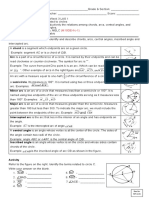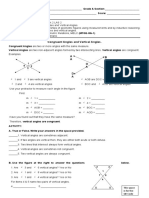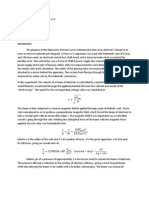0 ratings0% found this document useful (0 votes)
Math4 Q3 WK2 Las1
Math4 Q3 WK2 Las1
Uploaded by
Melanie Grace Ulgasan Lucero1. The document describes different kinds of angles - acute, right, and obtuse angles. It defines an angle as the figure formed by two rays or line segments with a common endpoint called the vertex.
2. An acute angle measures between 0 and 90 degrees, a right angle measures exactly 90 degrees, and an obtuse angle measures between 90 and 180 degrees.
3. The document includes an activity that asks students to identify different angles as acute, right, or obtuse using illustrations as examples.
Copyright:
© All Rights Reserved
Available Formats
Download as PDF, TXT or read online from Scribd
Download as pdf or txt
Math4 Q3 WK2 Las1
Math4 Q3 WK2 Las1
Uploaded by
Melanie Grace Ulgasan Lucero0 ratings0% found this document useful (0 votes)
1. The document describes different kinds of angles - acute, right, and obtuse angles. It defines an angle as the figure formed by two rays or line segments with a common endpoint called the vertex.
2. An acute angle measures between 0 and 90 degrees, a right angle measures exactly 90 degrees, and an obtuse angle measures between 90 and 180 degrees.
3. The document includes an activity that asks students to identify different angles as acute, right, or obtuse using illustrations as examples.
Original Title
MATH4 Q3 WK2 LAS1
Copyright
© © All Rights Reserved
Available Formats
PDF, TXT or read online from Scribd
Share this document
Did you find this document useful?
Is this content inappropriate?
1. The document describes different kinds of angles - acute, right, and obtuse angles. It defines an angle as the figure formed by two rays or line segments with a common endpoint called the vertex.
2. An acute angle measures between 0 and 90 degrees, a right angle measures exactly 90 degrees, and an obtuse angle measures between 90 and 180 degrees.
3. The document includes an activity that asks students to identify different angles as acute, right, or obtuse using illustrations as examples.
Copyright:
© All Rights Reserved
Available Formats
Download as PDF, TXT or read online from Scribd
Download as pdf or txt
0 ratings0% found this document useful (0 votes)
Math4 Q3 WK2 Las1
Math4 Q3 WK2 Las1
Uploaded by
Melanie Grace Ulgasan Lucero1. The document describes different kinds of angles - acute, right, and obtuse angles. It defines an angle as the figure formed by two rays or line segments with a common endpoint called the vertex.
2. An acute angle measures between 0 and 90 degrees, a right angle measures exactly 90 degrees, and an obtuse angle measures between 90 and 180 degrees.
3. The document includes an activity that asks students to identify different angles as acute, right, or obtuse using illustrations as examples.
Copyright:
© All Rights Reserved
Available Formats
Download as PDF, TXT or read online from Scribd
Download as pdf or txt
You are on page 1/ 2
Name:______________________ Grade & Section: ____________Score: _____________
School:_____________________ Teacher: ___________________Subject: Mathematics 4
LAS Writer: GENEVIE C. ARENO Content Editor: NIDA B. GARDOSE
Lesson Topic: Describing and Illustrating Different Kinds of Angles - Q3 Wk 2 LAS 1
Learning Target: Describes and illustrates the different angles (right, acute, and obtuse)
using models. (M4GE-IIIb-14)
References: Dela Cruz, E., Rapacon, C. and GLorial, J., 2015. Soaring 21st Century Mathematics.
Quezon City: Phoenix Publishing House, pp.184-186.
Different Kinds of Angles
Ray TS intersects ray TB at point T. When two lines, rays, or line
segment intersects at a common endpoint, they form an angle. Point T, the
S common endpoint is called the vertex of an angle. The symbol for an angle
is . In naming the angle, the vertex is always in the middle.
T 1 There are 3 ways to name the angle.
STB is read as “angle STB”.
B BTS is read as “angle BTS”.
T is read as “angle T” or 1 is read as “angle 1”.
An angle is measured in degrees (°). A protractor is used in measuring the angles.
Angles can be classified according to their measurement.
An acute angle measures more than 0° but EXAMPLE:
less than 90°. It is smaller than a right angle.
DOT or TOD is an acute angle.
A right angle measures exactly 90°. It is a
special angle that forms a square corner.
PRC or CRP is a right angle.
An obtuse angle measures more than 90° but
AEB is an acute angle.
less than 180°.
DEF is a right angle.
DOH or HOD is an obtuse angle.
CEF is an obtuse angle.
ACTIVITY
A. Identify whether each kind of angle is acute, right, or obtuse.
_________1. _________3. _________5.
_________2. _________4.
B. Identify the kind of angle formed as shown in the illustration. Number 1 is done for you.
acute angle
1. SOT - ________________
2. ROS - ________________
3. POS - ________________
4. POQ - ________________
5. POR - ________________
You might also like
- Learning Activity Sheet No. 2: Title: Describing and Illustrating Different Angles100% (3)Learning Activity Sheet No. 2: Title: Describing and Illustrating Different Angles5 pages
- Mathematics: Quarter 3 - Module 2: Kinds of AnglesNo ratings yetMathematics: Quarter 3 - Module 2: Kinds of Angles15 pages
- Math4 Q3M2 Visualizing AnglesTriangles and Quadrilaterals Garcia Jr. M Edited Layout 2-2-21No ratings yetMath4 Q3M2 Visualizing AnglesTriangles and Quadrilaterals Garcia Jr. M Edited Layout 2-2-2124 pages
- DLL - MATHEMATICS 4 - Q3 - W2 For Pixton Comic MakingNo ratings yetDLL - MATHEMATICS 4 - Q3 - W2 For Pixton Comic Making5 pages
- Angles in Circles Remedial Worksheet: O Is The Central Angle Subtended by Arc AB O ANo ratings yetAngles in Circles Remedial Worksheet: O Is The Central Angle Subtended by Arc AB O A6 pages
- Describing and Illustrating Different Kinds of Angles: Quarter 3 - Week 2No ratings yetDescribing and Illustrating Different Kinds of Angles: Quarter 3 - Week 24 pages
- Mathematics Activity Sheet: Quarter 3 - MELC 3No ratings yetMathematics Activity Sheet: Quarter 3 - MELC 34 pages
- CentralandInscribedAnglesdiscoveryactivity-1No ratings yetCentralandInscribedAnglesdiscoveryactivity-113 pages
- MATH 4 PPT Q3 W2 - Lesson 49 Describing and Illustrating Different Kinds of AnglesNo ratings yetMATH 4 PPT Q3 W2 - Lesson 49 Describing and Illustrating Different Kinds of Angles22 pages
- Grade 4 USLeM - Grade - 4 - Week 1 RevillaNo ratings yetGrade 4 USLeM - Grade - 4 - Week 1 Revilla8 pages
- Week - 4 - Lesson 2-Q2-Worksheet - Math 10 V2A100% (2)Week - 4 - Lesson 2-Q2-Worksheet - Math 10 V2A4 pages
- Math 4 - Quarter 3 - Lesson 3 - Kinds of Angles100% (2)Math 4 - Quarter 3 - Lesson 3 - Kinds of Angles35 pages
- Learning Activity Sheet Mathematics 10 Second Quarter - Week 3-4No ratings yetLearning Activity Sheet Mathematics 10 Second Quarter - Week 3-44 pages
- Unit 4 M3 Geometry Daily Problem Sets F18 RevisedNo ratings yetUnit 4 M3 Geometry Daily Problem Sets F18 Revised23 pages
- Module in Geometry Third Quarter Week 5 To 8No ratings yetModule in Geometry Third Quarter Week 5 To 813 pages
- Gr. 11 Investigation 2022 Euclidean GeometryNo ratings yetGr. 11 Investigation 2022 Euclidean Geometry6 pages
- MATH 4 PPT Q3 W2 - Lesson 49 - Identify The Different Kinds of Lines 2No ratings yetMATH 4 PPT Q3 W2 - Lesson 49 - Identify The Different Kinds of Lines 221 pages
- GR 4 Unit 7 Part 1 Measuring Angles Form ANo ratings yetGR 4 Unit 7 Part 1 Measuring Angles Form A4 pages
- Learning Activity Sheet #2 GRADE 10 MathematicsNo ratings yetLearning Activity Sheet #2 GRADE 10 Mathematics4 pages
- Gratitude Be Our Attitude and Praise Our PleasureNo ratings yetGratitude Be Our Attitude and Praise Our Pleasure13 pages
- School Oplan Balik Eskwela Public Assistance Command CenterNo ratings yetSchool Oplan Balik Eskwela Public Assistance Command Center1 page
- DM SGOD No. 094 S. 2023 UPSCALING CUM INDUCTION PROGRAM FOR BEGINNING TEACHERS IPBTNo ratings yetDM SGOD No. 094 S. 2023 UPSCALING CUM INDUCTION PROGRAM FOR BEGINNING TEACHERS IPBT26 pages
- Perfecting Charge PHASE CONJUGATION (What He Calls The TORSION FIELD) To Build A Electrosmog EliminationNo ratings yetPerfecting Charge PHASE CONJUGATION (What He Calls The TORSION FIELD) To Build A Electrosmog Elimination4 pages
- Statistical Mechanics of Liquids: Johan T. Padding Université Catholique de Louvain, BelgiumNo ratings yetStatistical Mechanics of Liquids: Johan T. Padding Université Catholique de Louvain, Belgium79 pages
- Seminar Presentation On Summer Training in Crompton GreavesNo ratings yetSeminar Presentation On Summer Training in Crompton Greaves16 pages
- Vapour-Liquid Equilibria XIV. The Ternary System Cyclohexane-Methanol-Hexane at 293.15 KNo ratings yetVapour-Liquid Equilibria XIV. The Ternary System Cyclohexane-Methanol-Hexane at 293.15 K15 pages
- Descriptive Research Designs Help Provide Answers To The Questions of Who, What, When, Where, and How AssociatedNo ratings yetDescriptive Research Designs Help Provide Answers To The Questions of Who, What, When, Where, and How Associated1 page
- IEEE 3DIC Conference, Munich, November 18, 2010: Tutorial 1 3D-SIC Design and TestNo ratings yetIEEE 3DIC Conference, Munich, November 18, 2010: Tutorial 1 3D-SIC Design and Test3 pages
















































































































